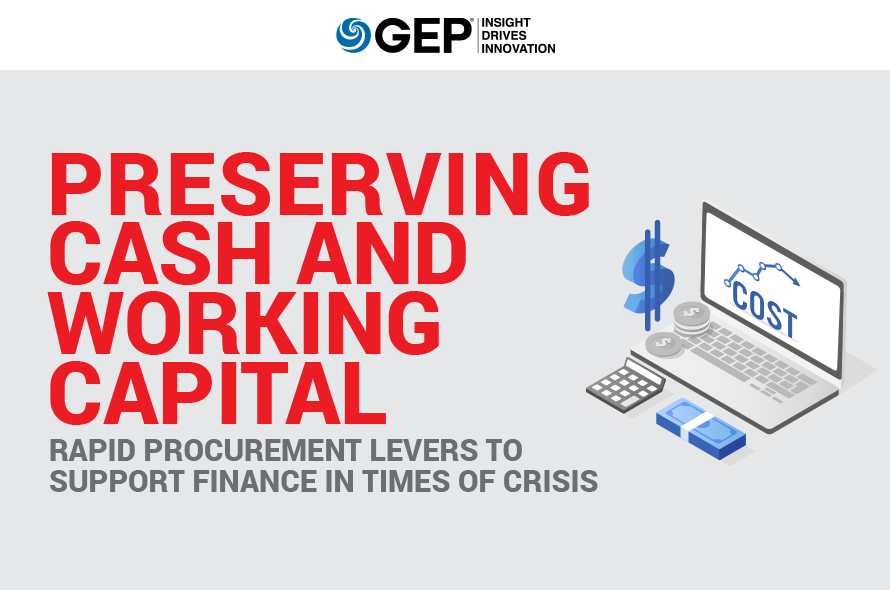Are your company’s cash reserves low?
Are there sufficient funds to tide over the COVID-19 crisis?
Most businesses, across sectors, are grappling with cash flow pressures, and CFOs are tapping all available options to ensure their companies don’t run out of cash. Procurement can help here.
The latest GEP BULLETIN, Preserving Cash and Working Capital: Rapid Procurement Levers to Support Finance in Times of Crisis, looks at how procurement can leverage suppliers to optimize cash flow quickly and come to mutually beneficial arrangements.
Why Read It:
- How to optimize supplier cost reductions and payment terms
- How to help your key suppliers survive the crisis
- Why it’s the right time to assess your supply base and re-negotiate
A must-read for procurement leaders who need to offer financial quick wins and make a business impact.
"When will things be back to normal?"
"Will it be a ‘new normal’?"
"Do we have the cash to weather multiple months of zero revenue?"
The coronavirus pandemic has raised many uncertainties, but the last question is perhaps what most businesses need to address urgently.
As countries lock down, people stay home and factories down shutters, affecting all business activities, CFOs are identifying and tapping all available financial instruments, including credit lines, to ensure that their companies don’t run out of cash. In parallel, enterprises are asking all internal operations to cut costs via salary reductions, reduce headcounts and stop purchases in indirect spend categories such as travel, marketing, supplies, etc.
At times like this, procurement, which is responsible for 40-70% of a company’s cost structure, has the opportunity to help mitigate the economic impact of the coronavirus and create even more value for the business.
We outline suggestions on managing the business impact of the coronavirus and how procurement can best leverage suppliers during a downturn, based on what GEP has specifically implemented for its clients:
You’re in It Together: Work with Suppliers to Optimize Cash Flow
- Get into pay-to-play supplier agreements to improve cash flow. This can be done in the context of accelerating future sourcing contracts for suppliers with strong balance sheets. For example, to secure a 2021 marketing contract, an agency can offer an upfront payment worth 5% of the contract value
- Optimize supplier cost reductions and payment terms. Do this for those suppliers facing dramatic demand reductions across multiple customers. For instance, help suppliers who are low on cash reserves stay viable with cash advances in return for future price reductions. Similarly, suppliers with low cash balances may try to securitize their accounts receivables. Customers with strong balance sheets can accelerate payments on offer for future price reductions. This reduces the lost value for suppliers working with third-party agents. On the other hand, suppliers with adequate cash reserves may be willing to trade upfront payments for future price increases.
- Seek opportunities to liquidate inventory across the value chain. This strategy is handy if there is inventory that may not be used for several weeks or months. Typically, a buyer can offer to buy the inventory at a price discount from the supplier in return for cash to keep the supplier financially viable during the crisis. In rare situations, when the supplier is the stronger company (for example, Apple selling to a retailer/distributor), the roles can be reversed.
- Negotiate on capital expenditures to avoid penalties. Cancellation and/or postponement of outlays for tooling and prototypes typically incur penalties. Avoid these with agreements with suppliers for additional future purchases.
Prep for the Future: Assess, Revaluate, Re-negotiate
- Assess the competitiveness of your supply base during this slowdown. Use supplier-specific dynamic should-cost models and identify suppliers that remain competitive across a wide range of demand scenarios.
- Re-negotiate agreements with core suppliers. For example, consolidate future volumes from the less competitive suppliers.
- Conduct accelerated negotiations with non-core suppliers. This can help secure price reductions for future business. Or use the opportunity to switch suppliers.
- Initiate joint process improvement activities. Given the lower business volume and demand on people’s time, this is a good time to launch such initiatives with suppliers that will pay off when volumes return — either in terms of reduced prices, improved quality or innovation.
- Assess outsourcing/master service provider agreements, where possible. It can help reduce spend levels and improve overall competitiveness.
- Assess supplier risk. Evaluate your tier 1 and tier 2 suppliers for financial and logistical risks. You can create a remediation plan for core suppliers at risk while exploring options to exit non-core suppliers at risk.
- Identify near-shoring options. For off-shore suppliers with long supply chains, find near-shoring options and start discussions to optimize total delivered costs.
- Improve compliance with contracts. There is greater supplier risk when there are off-contract purchases, which can impact productivity or quality. A downturn presents an opportunity to tighten internal procedures and enhance governance.
DO NOT LET A CRISIS GO TO WASTE: IMPROVE PROCUREMENT EFFICIENCY |
|
|---|---|
|
Coronavirus and recession may go hand in hand. The key to success is a willingness to convert this crisis into a longer-term advantage for your company. A quick diagnostic to establish where to start would be helpful. Clear communication and transparency with your supply base will help as its success is linked to your success. In parallel, your procurement function should make sure that other internal functions, such as manufacturing or engineering, understand what is being discussed with the suppliers, and provide support as needed. Program-managing the actions on a weekly basis keeps improvements on track — and provides visibility for making mid-course corrections.
The coronavirus’s effects on global markets will pass eventually — and the key objective for both your company and its main suppliers should be to come out stronger and more competitive than ever before.
RAPID RESPONSE SOLUTIONS FROM GEP
As the coronavirus crisis intensifies, managing your supply chain is going to get even more challenging. It may be worth finding a partner with deep experience in procurement and supply chain management to reinforce your capabilities and help you stay on course.
If you would like to have a conversation about how we can help, please reach out to our supply chain leadership.

John Piatek
Vice President, Consulting
John has over 15 years of strategy consulting experience managing several large-scale engagements with leading global clients.
At GEP, John is responsible for partnering with leading CPG and retail enterprises on strategy, supply chain and management initiatives. John is also the Chair of GEP’s Thought Leadership Council.

